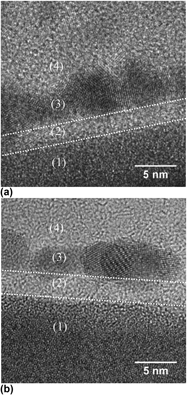Article contents
Bilayer amorphous carbon films synthesized by filtered cathodic vacuum arc deposition
Published online by Cambridge University Press: 25 July 2016
Abstract

A bilayer film deposition process for synthesizing ultrathin amorphous carbon (a-C) films with structure and properties dominated by those of the sp3-rich bulk layer was developed in this study. This was accomplished by incorporating in conventional filtered cathodic vacuum arc (FCVA) deposition a low-ion-energy pre-deposition step (no substrate biasing) leading to the formation of an ultrathin (<1 nm) carbon layer and a post-deposition step of high-energy Ar+ ion sputtering resulting in film thinning. The thickness and cross-sectional structure of hydrogen-free a-C ultrathin films synthesized by this multistep FCVA process under optimum substrate bias conditions (−100 V pulsed bias voltage) were examined by high-resolution transmission electron microscopy and electron energy loss spectroscopy. The bilayer a-C films synthesized under these conditions exhibit slightly higher sp3 fractions and interface and bulk layers significantly thinner and thicker, respectively, compared with single-layer a-C films of similar thickness deposited under the same FCVA conditions.
- Type
- Articles
- Information
- Copyright
- Copyright © Materials Research Society 2016
References
REFERENCES
- 7
- Cited by





